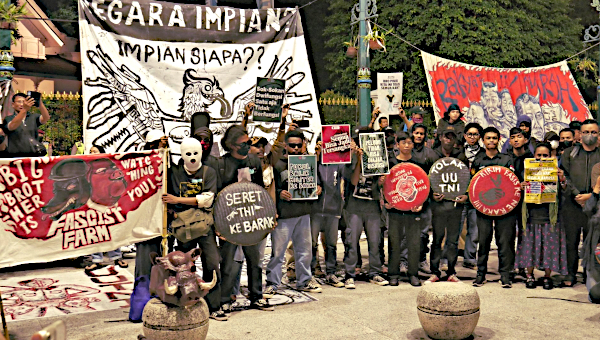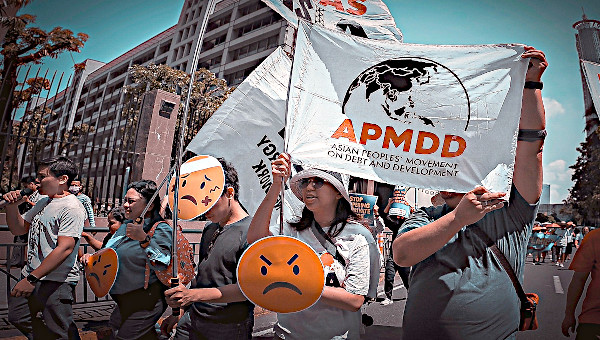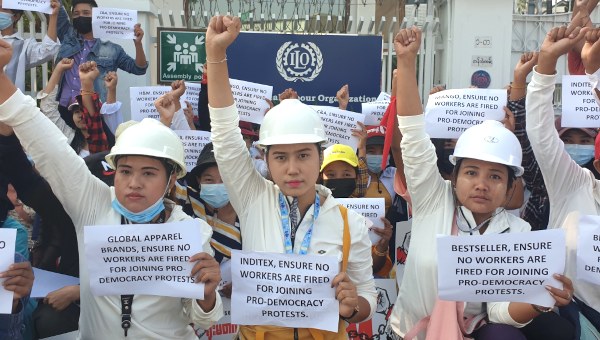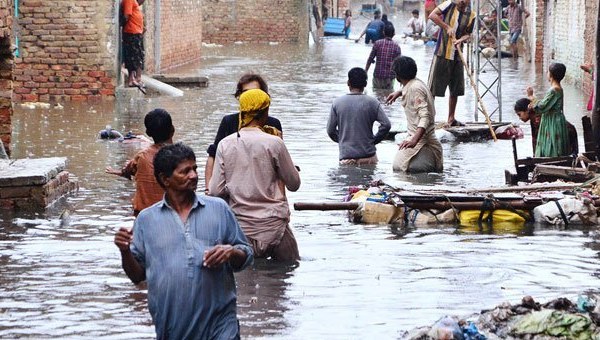War on Terror or Alliance with Islamic Terrorism?
It may sound rather odd in the face of the open war on terror that has been raging in Afghanistan and the Middle East to speak of United States’ alliance with Islamic terrorists, but that is the messy reality of our times. The United States, it seems, has decided to live with the contradiction of courting Islamic terrorists at the same time as it is waging a war on Terror.
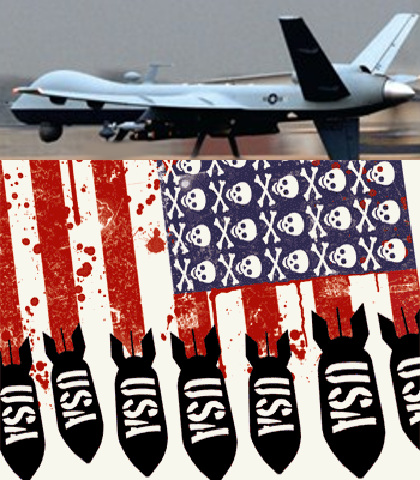
The seeds of the present day Islamic terrorism were in fact planted by the U.S. Central Intelligence Agency (CIA), by launching the code named “Operation Cyclone” in Afghanistan. The immediate aim of this Operation was to overthrow the USSR supported communist government of the People’s Democratic Party of Afghanistan (PDPA) which had taken over in April, 1978. However, this aim was overshadowed by the much wider American Cold War objective which, in the words of Zbigniew Brzezinski, former National Security Adviser to U.S. President Jimmy Carter, was “to provide the USSR with its Vietnam War.”[1]
The American CIA went around the world to recruit men to be mobilized and trained into a force of Islamic holy warriors, called Mujahideen to wage a holy war or jihad to expel the units of the Soviet Red Army that had entered the country to shore up the PDPA government which had run into internal problems soon after coming into power. According to one source between 1982 and 1990 as many as 35,000 Islamist militants were brought from outside into Afghanistan to wage this holy war.[2] Osama bin Laden of the al-Qaeda notoriety was one of them recruited for the CIA personally by the head of the Saudi Intelligence Service, Prince Turki bin Faisal.
Selig Harrison, a prominent area studies expert specializing in the AfPak region (Afghanistan and Pakistan theatre of war as president Obama calls it) is reported to have said at a conference that “CIA made a historic mistake in encouraging Islamic groups from all around the world to come to Afghanistan…”[3] Harrison may have seen the mistake in term of the eventual transformation of the Mujahideen into Islamist terrorists. But even from a humanist point of view the decade long war in which these outside fighters became a major force was no less a blunder as will be noted bellow. But before we get into that, let us look at the neighbouring state of Pakistan’s key role in this tragedy that hit Afghanistan.
The Key Role of Pakistan
Pakistan, with a history of close military ties to the Unites States, and a brand new military dictator who also happened to be an Islamic zealot, got drawn into playing a critical role in the holy war next door. Its involvement in Afghanistan’s CIA inspired Islamic insurgency can in fact be seen as part of its own politics of Islam or what is known as the Islamization of Pakistan. Whatever the motivation, the ruling elite of Pakistan has always been keen to make Pakistan an Islamic state.
As early as 1949, just two years after the creation of Pakistan, the ruling Muslim League got its landmark Objectives Resolution passed through the Constituent Assembly which made religious life of its predominantly Muslim population a business of the state. The Muslims of Pakistan, said the Resolution in part, “shall be enabled to order their lives in the individual and collective spheres in accordance with the requirements of Islam as set in the Holy Qur’an and Sunnah.”[4] This resolution was followed by a 1952 Report of the Basic Principles Committee of the Constituent Assembly prescribing that the head of the state shall be a Muslim, and that a board of Ulema (Islamic clerics) will be constituted to ensure that no legislation in Pakistan contravened the teachings of Qur’an and Sunnah. In 1956, when Pakistan’s first Constitution was belatedly produced, the country was named an “Islamic Republic.” The 1962 Constitution, formulated under the military rule of Ayub Khan, provided for an Advisory Council of Islamic Ideology which assigned the task of ensuring that no law of the country violated the teachings of Islam. When the present constitution of Pakistan was enacted in 1973 under the parliamentary rule of Prime Minister Zulfikar Ali Bhutto, it formally declared Islam as the state religion, and changed the designation of Advisory Council of Islamic Ideology to The Council of Islamic Ideology.
The real Islamization of Pakistan is said to have begun after July 5, 1977 when Gen. Muhammad Zia-ul-Haq staged a military coup and took over the government in Pakistan. The General having no other credible mandate to rule, used the real Islamization of Pakistan to stay in power. He claimed a divine mission to Islamize the Pakistani state,[5] and based the legitimacy of his regime squarely on that mission.
In practical terms, the centrepiece of Zia’s Islamization project turned out to be the Hudood Ordinances of 1979, prescribing “Islamic” punishments for apparently randomly selected offences of drinking, fornication, adultery, theft, and rendering false testimony. A former Chief Justice of the Supreme Court of Pakistan recalls that “During the Martial Law regime there have been public hanging and whipping. The events to take place were advertized in the newspapers and lacs of people gathered round the gruesome scene.”[6] That hundreds of thousand (lacs) people were gathered to watch these events, advertized in advance, hardly leaves any doubt that by having these gruesome scenes enacted Zia intended to terrorize his opposition, specially those who belonged to Bhutto’s party, the PPP. That party still seemed to be popular among the masses of the poor and powerless people according to intelligence coming from Pakistan Army and American sources.[7] It was no coincidence that those being picked up for alleged violations of Zia’s Sharia laws also happened to be poor and powerless.
The regime had in fact created a repressive environment in which media of mass communication were under strict censorship, political dissent was met with imprisonment and torture, and the Islamic Republic was staging an orgy of public floggings of the “sinful” under Sharia laws. What is significant to note is that this draconian rule had the “unstinting” support of the U.S. administration.[8]
In any case, feeling secure in the belief that he had the support of the United States, Zia continued to rule Pakistan in his despotic manner for about 11 years until he perished in the mysterious explosion of his plane in 1988. His sense of security, however, had vanished when the Soviets, rather unexpectedly decided to pull out of Afghanistan under the new leadership of Mikhail Gorbachev. In mid-May 1988 they signed the Geneva Accords to end the Afghan conflict. The only thing a frustrated Zia could do now was to find an excuse to dismiss the Prime Minister he had acquired since 1985 which he did, accusing him of laxity in an unrelated incident.
The Rise of Taliban and the War on Terror
After the Soviet Union completed the withdrawal of its troops under the Geneva Accords in 1989, the collapse of the PDPA government was only a matter of time. Kabul fell to the Mujahideen in 1992.
The fall of the PDPA government, along with the disintegration of Soviet Union a year earlier, was indeed a great Cold War victory for the United States to celebrate, but it was also a devastating blow to people of Afghanistan as the country plunged into chaos. Fierce fighting broke out among factions of Mujahideen for the control of land and power. In an attempt to bring Kabul under his control Gulbiddin Hikmatyar, the leader of Hizb-e-Islami destroyed much of Kabul with his heavy guns, killing more civilian men, women and children then all those killed in the decade long holy war of the Mujahideen. No one knows how many Malalas were killed after the fall of Kabul, but 1992 was also the last year that girls in Afghanistan could freely go to school and women to work.
It was out of this chaos and poverty stricken climate that yet another sinister Islamist group by the name of Taliban was born in 1994, and within a couple of years took over the rule of much of Afghanistan, but not without considerable help by Pakistan’s secret service agency, the ISI. The Taliban (meaning Students) were a mixed bag of physically and mentally battle-scared Afghan Mujahideen including many Pakhtun young men displaced by war and raised in the madrasas (Islamic schools) of Pakistan run by half-educated mullahs. Terrorism, a product of their rough hewn conceptions of the sharia laws of Islam combined, with their misogynist “Islamic” beliefs turned out to be the primary tool of their rule over Afghanistan. They massacred Shia Muslims, closed down or torched girls’ schools, beheaded men and women for alleged sexual offences, and in a show of self-righteous religious intolerance, demolished Afghanistan’s pre-Islamic cultural heritage by actions such as blowing up of the towering Buddha statutes of Bamiyan.[9]
It is interesting to note that all this terror of the Taliban rule hardly aroused any concern among the tribal elite of Afghanistan, or bother any outside powers that had rushed into Afghanistan to instigate Islamic jihad to suite their interests. The United States had no objection to Taliban’s rule, so long as they did not interfere with the U.S. oil companies’ trying to gain access to the Central Asian oil through pipelines to be laid out in Afghanistan.[10] Pakistan, Saudi Arabia and the United Arab Emirate officially recognized the Taliban regime as the legitimate government of Afghanistan. Although the United States held back from giving the Taliban regime an official recognition, President Reagan’s admiration for the Taliban was well reflected in his famous saying that: “These gentlemen are the moral equivalents of the founding fathers of America.”[11]
Then happened what the global media has portrayed as the quintessential act of terrorism known simply as 9/11, that is said to have changed the world for ever. Two hijacked passenger planes were flown, apparently by amateur suicidal pilots to crash into the Twin Towers of the Word Trade Centre, New York City, a third one hit the Pentagon buildings in Washington D.C., while a fourth crashed in a field in Pennsylvania on the morning of September 11, 2001, killing and injuring hundreds of people. Reportedly, it was the culmination of other smaller attacks, the bombings of U.S. embassies in Kenya and Tanzania for example, carried out earlier on U.S. targets by terrorists belonging to the al-Qaeda organization directed by Osama bin Laden.
President George W. Bush wasted no time after 9/11 in declaring War on Terror, code named, for some reason, Operation Enduring Freedom. By October U.S. war planes were bombing Afghanistan as the beginning of a highly unusual and open-ended war which is now into its second decade in the AfPak region where it seemed to be coming to an end, but its recent flare-up in the Iraq-Syria border leaves little room for optimism.
From War on Terror to Alliance with Terrorists: Beyond AfPak
Afghanistan was of course not the only country targeted by the United States in the aftermath of 9/11. Iraq was another country that suffered military invasion, although the case made for that invasion was very sloppy to begin with and is still widely believed to be incredible. As one can recall there were widespread protests, and massive popular rallies held globally against the planned attack on Iraq but to no avail. President Bush and his top officials kept insisting on fabricated evidence that president of Iraq, Sadaam Hussein, was in possession of weapons of mass destruction that could be used to launch terrorist attacks on the United States. According to this logic, the Iraq war (2003 – 2011) was more or less an extension of War on Terror launched earlier in Afghanistan, although after 9 years of bitter fighting at the cost of 4,500 U.S. lives and tens of thousands of Iraqi, wide-spread devastation in Iraq, and creation of bitter sectarian divisions, the U.S. troops were finally pulled out from that country at the end of 2011.
However, that pull-out may prove to be just a phase in the continuation of the War on Terror, as the United States is back in action in northern Iraq bombing the positions of the newly emergent “Islamic State” known also by its Arabic name of daish and the acronym of ISIS (Islamic State of Iraq and Syria). More on the Islamic State in a moment, for the understanding of which requires an introduction to an important shift in American policy of outright War on terror to alliance with Islamic Terrorists.
Unleashing Islamist Terrorists on Libya and Syria
In mid-February 2011, anti-regime demonstrations had broken out in Libya’s eastern city of Benghazi, a stronghold of President Gaddafi’s Islamist opposition, which at the time were reported to be part of the so-called “Arab Spring” movement which was sweeping through the Arab World in early 2011.[12] But as the Libyan law and order machinery moved in to deal with the demonstrations, the Security Council of the UN immediately went into session and on February 26 passed a resolution calling for a freeze on the assets of Gaddafi and several of his higher officials, charging that the Libyan authorities had used excessive force on the demonstrators killing their own people. The resolution also authorized the use of “all necessary measures to protect the Libyan people,” a phrase repeated by President Obama of the United States in a speech to the nation on March 28 while making it quite clear that it was his country that was instrumental for the convening of the Security Council meeting and the passing of the above mentioned resolution.[13]
The “Arab Spring” demonstrations by now had inexplicably turned into well armed insurgency against the Gaddafi regime. While the Libyan state media kept insisting that the insurgency was being led by al-Qaeda operatives, the U.S. led NATO war planes kept pounding Libya, and crippled the country’s defence forces clearing the way for a heavily armed militia to march into Tripoli, the capital of Libya. Then on October 20 the global television networks began to flash grisly images of a bloodied Muammar Gaddafi being lynched to death amidst shouts of Allah-o-Akbar (God is Great). Reportedly this was happening in Gaddafi’s hometown of Sirte from where he was trying to escape to safety, but his convoy was pinned down by the strafing of NATO war planes, providing the opportunity of ground militias to grab and kill him.
It is no longer a secret that the main militia leading the anti-Gaddafi charge on the ground was being led by the Libyan Islamic Fighting Group (LIFG), well known to the U.S. authorities since it was active in the 1980s jihad in Afghanistan. After the fall of the PDPA government in 1992 this group linked up with al-Qaeda, and vowed to replace the secular government of Gaddafi with an Islamic one. The U.S. government formally declared it a Foreign Terrorist Organization (FTO) in 2004. However, in 2011, the U.S. made a common cause with this “terrorist” group to remove Gaddafi from Libya. It was Asdel Hakim Belhadj, a leader of the LIFG, well known to CIA, who was in command of the militia that marched into Tripoli under NATO air cover and removed the Gaddafi government in August 2011. With end of the Gaddafi regime completed, Belhadj took off to Syria to fight with the Islamists to overthrow another secular regime in the Middle East.
But back in Libya the work of Islamist terrorists was not over yet. On September 11, 2012 a group calling itself Ansar-al-Sharia (friends of sharia) along with some LIFG members stormed the Benghazi consulate of the United States and killed Chris Stevens, the young U.S. ambassador to Libya. For the ordinary minds there might be a lesson to be drawn from the assassination of the U.S. ambassador: terrorists will be terrorists, and therefore it never pays to partner with them in any venture. But then the policy makers of the only Superpower on earth are no ordinary minds. Islamist terrorists were their allies and strategic assets now, as they went ahead to show in their next battle to bring about regime change in Syria.
In Syria small peaceful protests, possibly again a part of the same wave of Arab Spring demonstrations that had erupted elsewhere in the Middle East, started in January, 2011.[14] Ironically an important factor specific to Syria in these demonstrations was the economic hardship resulting from the neoliberal reforms espoused by Bashar al-Assad. The neoliberal reforms carried out earlier in Syria hit the lower income groups especially hard because of the dismantling of the country’s sizable public sector and its significant range of social programmes.
By mid March, when the protests became louder and inexplicably violent, the same cluster of states that had taken military action in Libya, i.e. the NATO Europeans, and the Arab petro-monarchies, led by the United States decided to intervene and go after Bashar al-Asaad’s head. First, the U.S. administration tried to get resolutions passed through the Security Council that would allow the imposition of “No fly zone” over Syria, similar to the one which allowed air attacks on Libya, and brought a bloody end to the Gaddafi regime.
However, that move failed because some members of the Security Council, having witnessed what had happened in Libya, were in no mood to hand over another resolution to the United States and its NATO allies which they could use to do as they pleased with regard to Syria. But having been so rebuffed the U.S. diplomats took the issue out of the chambers of United Nations in New York to the oil rich desert Sheikhdom of Qatar. Here in the air conditioned comfort of Luxury hotels they conferred with their NATO and Arab allies in November 2012 to plan the financing and arming of a group of Islamist terrorists once again to battle the secular government of Bashar al-Assad in Syria.[15]
The Islamic State
Unlike the Libyan government of Gaddafi, however, the Syrian authorities were ready for the onslaught of these terrorist groups, among whom the al-Nusra Front, a Syrian affiliate of al-Qaeda was the largest. It has fought Assad’s government most actively with terrorist tactics as well as regular force of arms. Having battled on behalf of the United States and its allies for almost 3 years at the cost of about 175,000 Syrian men, women and children killed, and millions more driven out of their homes and country as refugees, al-Nusra has realized that the war waged against the Syrian regime has turned into a stalemate. With that realization it has turned to the Islamic State.
The political entity that has lately sprung up in news as Islamic State seems to be the kind of umbrella organization representing the aims and aspirations of Syrian Islamist groups as well as the strategic policy makers of the United States still leading the War on Terror. But what is the Islamic State, one may ask. Much has been written on it over the short period since it began to make media headlines. The following sketch of the newly emergent state is derived from these writings.
Abu Musab al-Zarqawi, one of the outsider Mujahideen who fought in the Afghan proxy war of the 1980s launched the Islamic State of Iraq (ISI) while he had redirected his fight against the U.S. presence in that country. He was killed by a U.S. targeted strike in June 2006. The name of the ISI was changed by his successors into Islamic State of Iraq and Syria (ISIS) in April 2013 when ISI was expanded to include Syria’s al-Nusra Front. On June 29 the name of the new state was changed again to just Islamic State. It was declared a Caliphate and Abu Bakr Baghdadi took over as the caliph.
Ideologically, the Islamic state subscribes to Sunni Islam of the fundamentalist Saudi Wahabi (salafi) sectarian persuasion, combined with a belief in no separation of religion and politics. It is rabidly anti-Shia and intolerant of religious minorities. From the composition of its leadership and political philosophy the roots of the Islamic State can be traced to the U.S.-sponsored Islamic jihad of the 1980s when the CIA in collaboration with Pakistan and Saudi Arabia mobilized a force of militant Islamists and injected them into the politics of Afghanistan. The portrayal of some gruesome actions in the media, such as individual and collective beheadings indicate that it is a terrorist state. It should, however, be kept in mind that this Islamic State is only a recent appendage to the Islamic terrorists who have been around for much longer, and perhaps outlast it.
Conclusion
This, rather off-the-beaten-track review of today’s Islamist terrorism, portrays the role of United State as critical but contradictory. That Superpower let the genie of Islamist terrorism out of the bottle by mobilizing a force of holy warriors, Mujahideen, in the 1980s Afghanistan through CIA. Then in the aftermath of 9/11 it started the war on terror, first in Afghanistan and two years later in Iraq. And before the two wars could produce anything close to a victory over terror, the United States was in cahoots with Islamist terrorists, first in Libya, and then in Syria.
These kinds of diplomatic somersaults are not unusual to the foreign policy makers of United States, guided as they are by the principle of political realism whereby perceived national self-interest is the key to determine relations with other players in the international arena. So, at the moment United States is at war with the Islamist terrorists in the recently founded Islamic State, but allied with them in Syria to overthrow the Assad regime, the mythology of moderate Islamists (good) and extremist Islamists (bad) notwithstanding.
To look at it a bit more closely, this war is a war of domination, although the rationale of domination differs between the two antagonistic sides. The United States wants to dominate the world as an imperialist power whereas the terrorists want to dominate the world as an Islamic power. It is in this context that the Islamists are in action on more than one fronts. They believe that for Islam to dominate the world, it must constitute a uniform system of beliefs and practices, and that system is the Sunni Wahabi or Salafi Islam of Saudi Arabian origin. All other Sunni sects will sooner or later be absorbed into the Wahabi Islam either voluntarily or by force. But in the case of the Shia and some other sects that differ from the Wahabi orthodoxy too much, the only option is the so-called final solution. They will have to be killed off. Some of the terrorist Islamist groups, such as the Jundullah, operating on the Iran-Balochistan border and the Sipah-e-Sahaba, operating in the urban areas of Pakistan specialize, in the killing of Shias.
On another point, at the beginning of this paper responsibility for the promotion of Islamist terrorism was attributed to United States, aided, of course, by the Saudi royals, and Pakistan’s dictator Zia who had his own terrorism going. In order to fully understand this, and similar practices, one has to recognize that the United States is a surveillance state. As such, it needs to keep terrorists and terrorist threat to its people alive in order to rationalize that surveillance is necessary for everyone’s safety.
And finally, we conclude by raising an issue rarely brought up in discussions of the type undertaken here, yet happens to be very relevant and important both from a humanitarian and scientific points of view. What has been happening in Iraq and Syria, among other things, is the obliteration of the cultural heritage of humankind through ground and aerial bombardment, deliberate dynamiting and pilferage. The Heritage being destroyed includes museums, historical and pre-historical artefacts, rare manuscripts, temples, shrines, churches and mosques scattered throughout the region that has been known as the cradle of civilization. Tragically, involved in this process of destruction and obliteration is the sole Superpower, and admittedly, one of the most civilized nations, on Earth.
Of course very little can be done to retrieve, protect and safeguard various aspects of the heritage in question for the benefit of present as well as future generations in the climate of continued war. But this has to be done, and ways have to be found to do it. •


